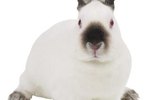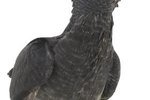
Dutch rabbits (Oryctolagus cuniculus) are a domesticated breed native to Holland in western Europe. These wee rabbits have enjoyed immense popularity over the years, and are one of the oldest breeds of domestic rabbit. Not only are Dutch rabbits commonly seen as pets, they frequently are featured in rabbit shows, as well.
Physical Appearance
Mature Dutch rabbits typically weigh anywhere between 3.5 and 5.5 pounds or so. They have robust and densely built physiques, with lustrous and short coats. Their heads are circular and their ears are broad. Recognized by distinctive markings, Dutch rabbits always have white segments on their bodies -- on their faces, shoulders, necks and feet. Their remaining fur, however, is a different color, typically deep brown, gray, black, grayish-brown, blue or tortoiseshell. Tortoiseshell Dutch rabbits' coats generally combine elements of brown with pale yellowish-beige.
Life Expectancy
With good care, Dutch rabbits often live between 5 and 10 years, occasionally longer. Good care includes everything from feeding them proper, hay-packed diets to taking them to regular veterinary appointments. Adequate, routine physical exercise is also key for them. Spaying or neutering procedures are often beneficial for promoting longevity in these furry creatures. Some Dutch rabbits have even lived to around 15 years in age.
General Disposition
With their docile, laid-back and serene dispositions, Dutch rabbits are beloved as household pets. A good pet choice for kids 10 years of age and up, always keep a close watch on any interactions shared between younger children and Dutch rabbits, just to be cautious. Training Dutch rabbits usually is no biggie as they tend to be rather smart cookies. They thrive on regular interplay with humans, and are usually rather active and peppy in nature. Note that they often tend to become more and more biddable with the more contact they receive from people.
Protective Mechanisms
Although many Dutch rabbits live cozy lives in homes with their human owners, they still retain some protective mechanisms in the event of nearby predators. Sizable ears, for example, are situated conveniently on the edge of their heads. This handy location allow them to quickly spot threats, no matter where they're coming from. Dutch rabbits also are equipped with extremely tough hind limbs, enabling them to rapidly escape perilous situations.
Breeding
Female rabbits are pregnant for roughly 31 days. A litter typically consists of 6 or 7 youngsters, all of which are highly dependent on parental assistance. The kits are devoid of fur and cannot see at all, although that begins to change when they're around 10 days in age. Weaning usually occurs when the little ones are about 1 month old. Rabbits can be extremely prolific breeders. The females sometimes welcome a maximum of five litters annually.
References
- American Dutch Rabbit Club: About the Breed
- Verlannahill Rabbitry: About Dutch Rabbits
- Dutch Rabbits: Care for Your Rabbits
- Cosley Zoo: Dutch Rabbit
- United Kingdom Dutch Rabbit Club: Dutch Standard
- SmallAnimalChannel.com: Dutch Critters
- Rabbits - The Animal Answer Guide; Susan Lumpkin and John Seidensticker
Photo Credits
-
John Foxx/Stockbyte/Getty Images




